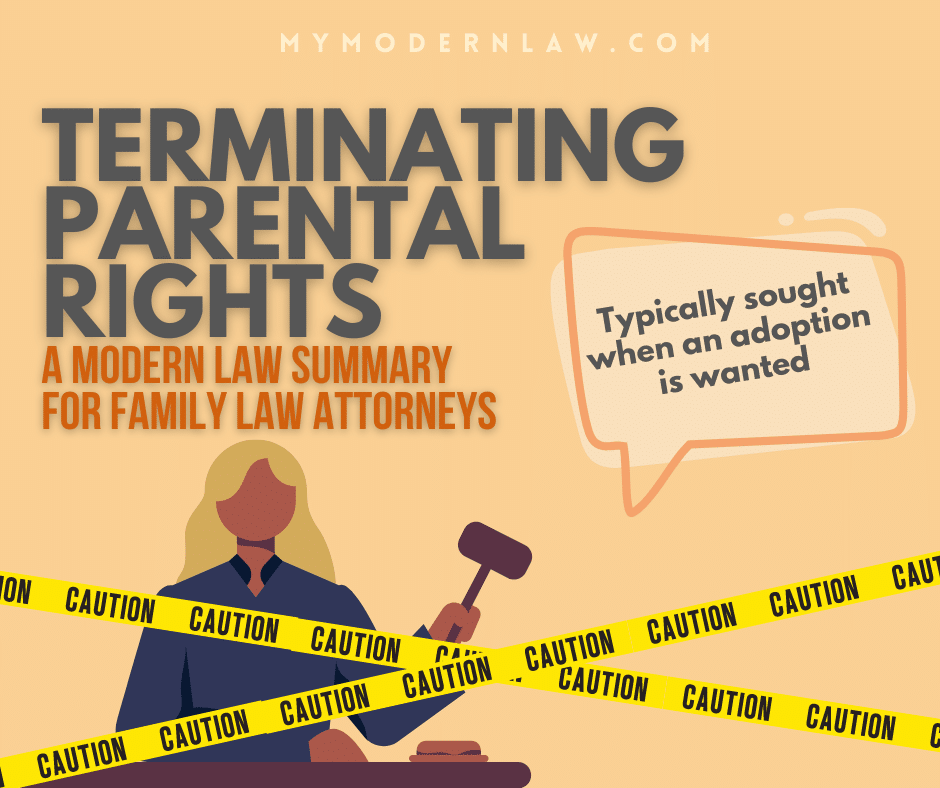Making way for step parent adoption
For attorneys working in family law, the termination of parental rights remains one of the most profound actions a court can take. It’s a legal process that severs the bond between a parent and their child, extinguishing the rights and responsibilities held by the parent. This article summarizes critical insights from a recent presentation for attorneys by Modern Law’s Kylie Bigelow, who specializes in parental rights, explaining when and how this drastic measure is applied in the legal system.
Key Players
- The parents
- The children
- Guardian Ad Litem or Best Interest Attorney
- Appointed Counsel
- Private third-party petitioners
- Social Study Providers
The Legal Framework
At the heart of the termination process is a set of statutes that outlines the specific grounds and procedures for severing parental ties. It’s essential to understand that these cases are exclusively handled in juvenile court, highlighting the specialized nature of these proceedings.
Grounds for Termination
A parent’s rights can be terminated on various grounds, but before the court even considers the best interests of the child, these grounds must be proven:
- Abandonment: Often cited, abandonment is characterized by a lack of contact or financial support for about six months. However, the circumstances can be nuanced, especially if efforts to contact the child are obstructed by the other parent.
- Neglect or Abuse: This includes physical harm or the failure to provide for the child’s basic needs. Emotional abuse alone rarely suffices for termination.
- Inability to Discharge Parental Responsibilities: Factors such as chronic substance abuse or mental illness that are likely to continue pose significant grounds for termination.
- Deprivation of Civil Liberties: Serious crimes against the child or another family member can lead to termination.
- Failure to File for Paternity or Relinquishment: In scenarios involving adoption or guardianship, a lack of legal acknowledgment of paternity can be a basis for termination.
- Reunification Failures
When these efforts repeatedly fail—due to unsafe conditions, non-compliance with court orders, or lack of progress—termination may be considered.
The Process
The termination process is initiated by filing a petition, followed by a series of hearings to establish the grounds and consider the child’s best interests. Critical to this process is the role of social studies, which evaluate the child’s living conditions, the parent’s ability to meet their needs, and the proposed plans for the child’s future.
When the Process Fails
When the severance is contested, Bigelow prefers to see a social study done, ordered by the court. “Then the court will usually schedule a pre-trail conference just to set deadlines for everything, and then, more often than not, they will want the parties to attend mediation.”
It’s not always a successful process, and there have been occasions where the parties agree to some form of an open adoption as an alternative.
Key Aspects of the Step-Parent Adoption Process:
- Termination Precedent: The biological parent’s rights must be terminated, clearing the way for the adoption.
- Legal and Emotional Readiness: The step-parent must be married to the child’s legal parent and have lived with the child, demonstrating a commitment to providing a loving, stable home.
- Child’s Consent: Older children may need to consent to the adoption, ensuring their voices are heard in decisions affecting their lives.
- Simplified Procedures: In certain cases, requirements such as social studies may be waived to streamline the adoption process for families already providing a stable environment for the child.
Summary
The termination of parental rights, while a profound legal measure, is sometimes necessary for the child’s best interest. It is a process marked by legal rigor and emotional complexity, aimed at ensuring the child’s safety and well-being. Following termination, step-parent adoptions represent a hopeful pathway to new beginnings, offering legal solidity and emotional security within a new family structure. Understanding these processes is crucial for anyone involved, highlighting the law’s ultimate focus on fostering the best possible outcomes for children amidst challenging circumstances.






